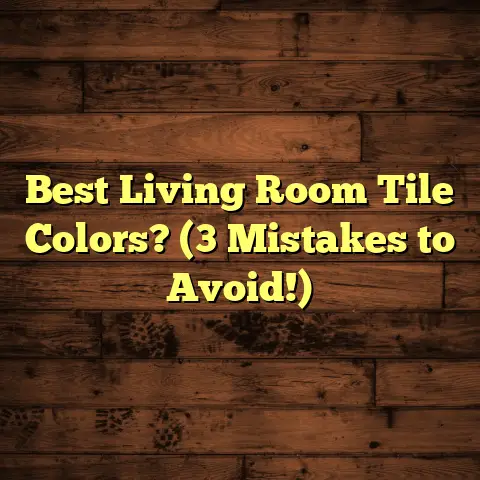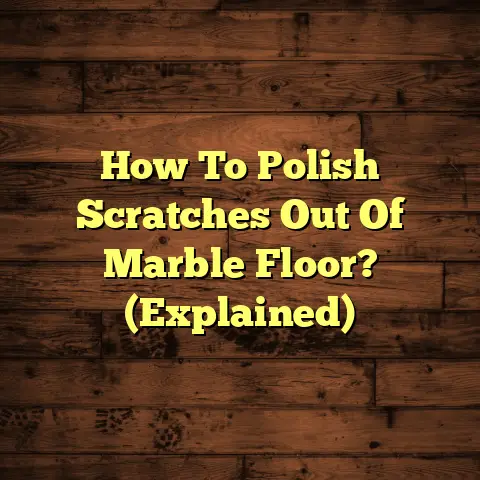Water Ruining Your Wood Floor? (7 Signs Of Rot!)
Remember that scene in “Titanic” where the water crashes through the grand staircase? Or how about the rain-soaked kiss in “The Notebook,” all dramatic and emotional? Water is powerful, and while it makes for great cinema, it’s a total nightmare for your wood floors.
I’ve seen it all in my years as a flooring contractor. Water damage is a silent intruder, creeping into our homes and wreaking havoc on one of our biggest investments. Let’s dive into how to spot it, understand it, and stop it.
Section 1: Understanding Wood Flooring
and Its Vulnerabilities
Wood flooring is beautiful, adding warmth and character to any home. But let’s face it, wood and water are not friends.
Think of wood like a sponge. It’s porous, meaning it has tiny holes that can absorb moisture. When water gets in, it causes the wood to swell, warp, and eventually rot. This is because wood is primarily composed of cellulose, which is a tasty treat for fungi when it’s wet.
Now, not all wood floors are created equal. Here’s a quick rundown:
-
Solid Hardwood: This is the real deal – planks made from a single piece of wood. It’s gorgeous and durable, but also the most vulnerable to moisture.
-
Engineered Wood: This is made of layers of plywood with a hardwood veneer on top. It’s more stable than solid hardwood and less prone to warping, but still susceptible to water damage.
-
Laminate: This is a synthetic material that mimics the look of wood. It’s the most water- resistant option, but if water seeps in through the seams, it can still cause problems.
Rot is the ultimate enemy. It’s the decay of wood caused by fungi. Not only does it compromise the structural integrity of your floor, but it can also lead to health problems and a hefty repair bill.
Section 2: The Importance of Early Detection
Why is spotting water damage early so crucial? Because the longer you wait, the worse it gets.
Think of it like a small leak in your roof. If you catch it early, you can patch it up with minimal damage. But if you ignore it, the leak will grow, leading to rot, mold, and eventually, a collapsed ceiling.
The same goes for your wood floors.
According to the EPA, water leaks account for more than 1 trillion gallons of water wasted each year nationwide. (Source: EPA WaterSense)
And the financial implications can be staggering. The average cost of water damage restoration is around \$3,000, but it can easily climb into the tens of thousands depending on the extent of the damage.
That’s why knowing the signs of rot is so important. Let’s get into the details!
Section 3: Sign 1 – Discoloration
One of the first signs of water damage is discoloration. This can manifest as dark spots, light spots, or even a general dullness to the wood.
-
Dark Spots: These are often caused by mold or mildew growth. The water creates the perfect environment for these fungi to thrive, leaving behind unsightly stains.
-
Light Spots: These can be caused by water bleaching the wood or by mineral deposits left behind as the water evaporates.
I remember one client who called me in a panic because she noticed dark spots appearing on her oak floor after a heavy rain. Turns out, a window had been leaking, and the water was seeping under the sill and onto the floor. We were able to repair the damage, but if she had waited any longer, the rot would have spread, requiring a full floor replacement.
Here are a few images to show what discoloration can look like:
(Imagine images here: 1. Dark spots on oak floor 2. Light spots around baseboard 3. Overall dullness of wood floor)
Section 4: Sign 2 – Warping and Buckling
When wood absorbs excess moisture, it expands. And when it dries, it contracts. This constant swelling and shrinking can cause the wood to warp and buckle.
Warping is when the wood becomes curved or twisted. Buckling is when the planks lift up from the subfloor, creating a raised, uneven surface.
Not only is this unsightly, but it can also be a tripping hazard. Plus, it can damage your furniture and make it difficult to clean the floor.
I once had a customer who had a beautiful maple floor in her kitchen. One day, she noticed that the planks near the dishwasher were starting to buckle. After investigating, we discovered that the dishwasher had a small leak that had been going on for months. The water had seeped under the floor, causing the wood to swell and buckle. We had to replace a large section of the floor, which was a costly and time- consuming project.
Section 5: Sign 3 – Soft or Spongy Texture
Waterlogged wood loses its structural integrity. It becomes soft and spongy underfoot, almost like walking on a wet sponge.
This is a clear sign that the wood is rotting. The fibers are breaking down, and the wood is no longer able to support weight.
I’ve had homeowners tell me they noticed a “squishy” feeling when they walked across certain areas of their floor. This is a classic symptom of rot.
If you notice this, don’t ignore it! It’s a sign that the damage is severe and needs immediate attention.
Section 6: Sign 4 – Foul Odors
Mold and mildew thrive in damp conditions. And when they grow on your wood floors, they release unpleasant odors.
These odors can range from musty to earthy to even a bit like dirty socks. If you notice a persistent foul odor in your home, especially near your wood floors, it’s a good idea to investigate.
Mold isn’t just smelly, it can also be a health hazard. It can trigger allergies, asthma, and other respiratory problems.
According to the CDC, mold exposure can cause a variety of health problems, including nasal stuffiness, throat irritation, coughing or wheezing, eye irritation, or skin rash. (Source: CDC Mold)
That’s why it’s so important to address the source of the water quickly and remove any mold growth.
Section 7: Sign 5 – Visible Mold Growth
Speaking of mold, sometimes you can actually see it growing on your wood floors. It can appear as fuzzy, discolored patches.
Mold can be black, green, white, or even orange. It often grows in areas that are dark, damp, and poorly ventilated, such as under furniture or behind appliances.
If you see mold, don’t try to clean it up yourself. It’s important to wear protective gear, such as a mask and gloves, to avoid inhaling the spores. It’s best to call a professional mold remediation company to safely remove the mold and address the source of the water.
Section 8: Sign 6 – Gaps Between Planks
Remember how I said wood expands when it gets wet and contracts when it dries? This constant movement can cause gaps to form between the floor planks.
These gaps are a sign that the wood is being exposed to excessive moisture. The wood is expanding and contracting, pulling away from the adjacent planks.
These gaps can be unsightly, and they can also allow more water to seep down into the subfloor, exacerbating the problem.
(Imagine visuals here: 1. Close-up of gaps between planks 2. Diagram showing wood expanding and contracting)
Section 9: Sign 7 – Excessive Cupping
Cupping is a specific type of warping where the edges of the planks rise higher than the center, creating a concave shape. It’s like the planks are trying to form a cup.
Cupping is usually caused by moisture imbalance. The bottom of the planks are wetter than the top, causing them to expand more.
This can be caused by a leak in the subfloor, high humidity levels, or even improper cleaning techniques.
Cupping can make your floor feel uneven and uncomfortable to walk on. It can also damage the finish and make the floor more susceptible to scratches and dents.
Section 10: Long-term Consequences of Ignoring
Water Damage
Ignoring water damage can have serious long-term consequences. It’s not just about aesthetics. It’s about the structural integrity of your home.
Here are just a few of the potential problems:
-
Structural Damage: Rot can weaken the floor joists and subfloor, compromising the stability of your home.
-
Mold Infestation: Mold can spread throughout your home, affecting your air quality and causing health problems.
-
Insect Infestation: Damp wood is an attractive nesting ground for insects, such as termites and carpenter ants.
-
Decreased Home Value: Water damage can significantly reduce the value of your home.
I spoke with Sarah, a local real estate agent, who said, “Water damage is a huge red flag for potential buyers. It can scare them away or force them to make a much lower offer.”
Don’t let water damage ruin your home. Take action now to protect your investment.
Conclusion
Your wood floors are more than just a surface to walk on. They’re an investment in your home, your comfort, and your well-being.
Just like Jack and Rose in “Titanic,” we need to be vigilant and protect our homes from the destructive power of water. Don’t let a small leak turn into a major disaster.
Be proactive, be observant, and don’t hesitate to call a professional if you suspect water damage.
Call to Action
Have you ever experienced water damage to your wood floors? Share your stories in the comments below!
And if you suspect your flooring may be at risk, don’t wait! Contact a qualified flooring contractor for an inspection and repair. It’s better to be safe than sorry.





